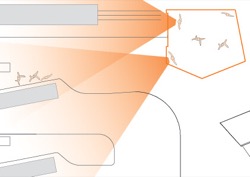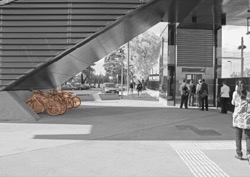On this page:
About public transport environs
Public transport environs includes the public spaces, streets, buildings and activities located around railway stations, bus and tram interchanges, and adjacent to railway corridors.
Why is it important?
Where public transport nodes are located near other activities and facilities, they provide mutual support through enhanced convenience and accessibility, and a safer public realm.
This element assists in delivering enhanced safety and amenity in the public realm and in private development in the vicinity of railway stations, public transport interchanges, and railway corridors.
The engineering, servicing or management issues of the public transport are guided by other appropriate authorities. Refer to Public Transport Guidelines for Land Use and Development.
4.1.1: ensure convenient pedestrian and bicycle access to railway stations and public transport interchanges
- Provide continuous, direct pedestrian and bicycle access routes from the surrounding neighbourhood to railway stations and public transport interchanges.
Tip: pedestrian and bicycle access routes to a public transport node should accommodate both public transport users and others moving around the neighbourhood. More people on the paths will create a safer environment.
- Provide a continuous active frontage along pedestrian approach paths to railway stations and public transport interchanges.
Tip: pedestrians feel unsafe where vacant lots or blank walls front pedestrian paths.
- Arrange pedestrian approach paths with clear sightlines to and from railway station buildings, and to and from public transport interchanges.
- Where a bus or tram interchange is co-located with a railway station, connect them with a direct, sheltered pedestrian path.
4.1.2: ensure safety and amenity around railway stations and public transport interchanges
- Locate active public spaces and secondary uses adjacent to railway stations and public transport interchanges.
Tip: active public spaces and secondary uses, such as food vendors, or drycleaners, can attract other people to the railway station or public transport interchange area. This helps increase the numbers of people using the station or interchange area and improves security.
- Locate public transport waiting areas, particularly pick-up and drop-off areas, and taxi ranks where they are clearly visible from the pedestrian approach paths and nearby buildings.
- Where railway stations are co-located with a bus interchange, arrange waiting areas with clear views to approaching buses.

Tip: sharing waiting areas for train and bus travellers can increase activity levels and contribute to a sense of safety.
4.1.3: ensure comfortable and serviceable railway stations and public transport interchanges
- Provide weather protection, comfortable seating and public amenities, such as waste bins and drinking fountains.
- Locate way finding signage at logical and visible points along approach paths to and within the railway station or public transport interchange.
- Locate real–time travel information where it can be seen by waiting passengers in all light conditions.
Tip: when selecting a location for electronic display screens take into account the effects of bright sunlight and sun angles on screen visibility.
- Provide both casual and secure bicycle storage near the railway station or public transport interchange.

Tip: casual bicycle storage, such as hoops, provide an easy–to–use facility, while secure cages provide for longer term storage.
4.1.4: ensure the railway station or public transport interchange contributes to a sense of place and local character
- Develop a palette of materials, furnishings and plantings for public space within the railway station precinct or public transport interchange that is consistent with the preferred palette of the surrounding area.
Tip: where multiple agencies deliver infrastructure and urban design works, a consistent palette of fixtures and finishes enables co–ordinated repairs and contributes to a sense of place.
4.1.5: effectively maintain public transport environs
- Establish a place management agreement that identifies management and maintenance responsibilities and processes.
Tip: public transport interchanges and their adjacent public spaces have different agencies responsible for management. A place management agreement and place maintenance processes can assist a coordinated and consistent approach.
Page last updated: 28/10/25